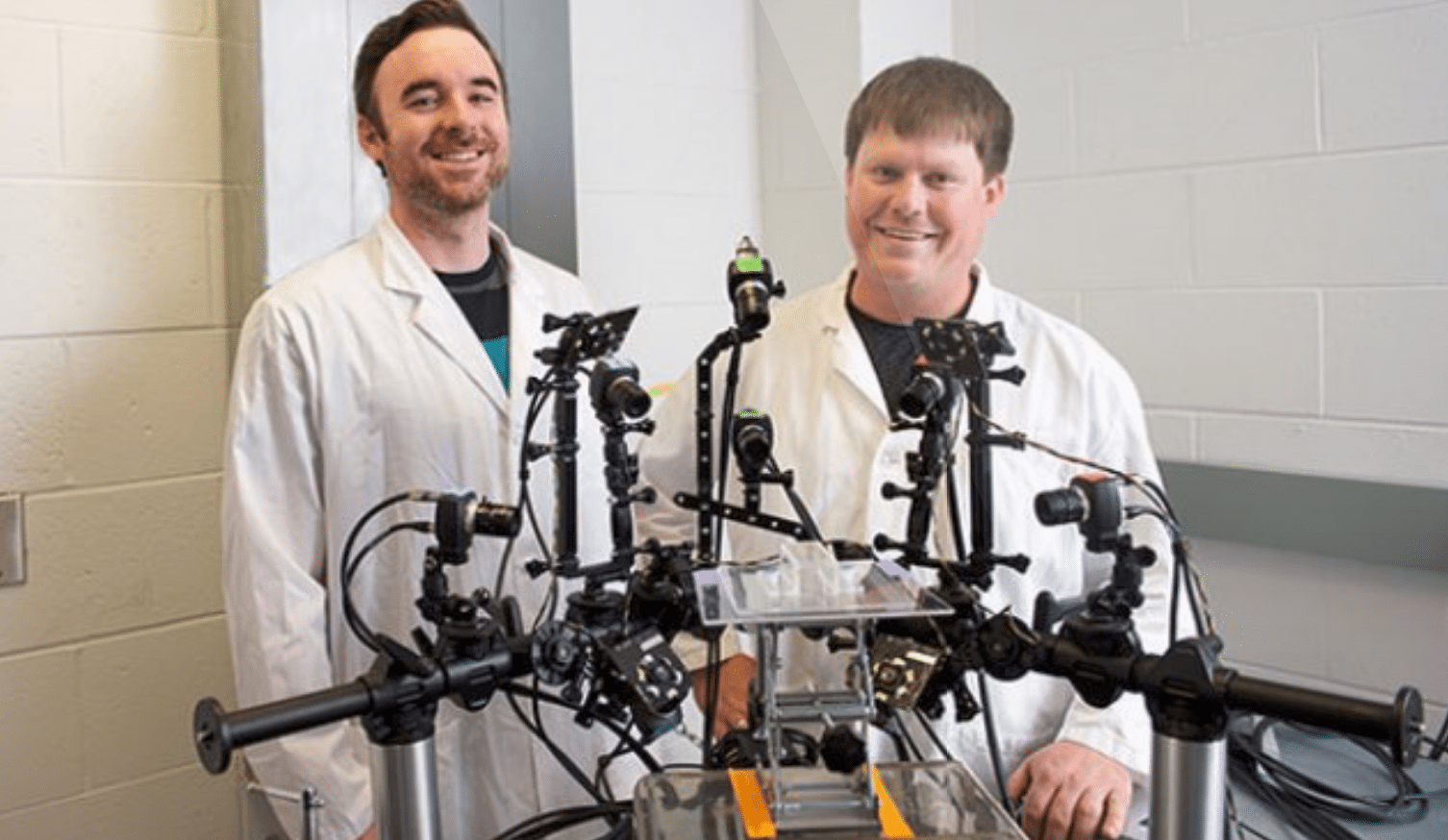New VA Research On TBI Migraines, Light Sensitivity
VA recently published new research coming out of the Iowa City VA’s Center for the Prevention and Treatment of Visual Loss.
A new study aimed at learning more about regions of the brain that may play a role in migraines and photophobia. He and his team have been focusing mostly on the posterior thalamus. It’s just above the brain stem between the cerebral cortex and the midbrain.
The following in italics is a VA write-up of the new research published on its VAntage Point blog:
Center for the Prevention and Treatment of Visual Loss
Traumatic brain injuries, a frequent consequence of the wars in Iraq and Afghanistan, can lead to such debilitating symptoms as irritability, depression, insomnia, memory deficits—and post-traumatic headaches, which are similar to migraine headaches.
Migraine is a potentially disabling disorder, causing severe headaches that can last days at a time and pose huge health care costs to the patient and society. A key component of migraines is photophobia, an extreme sensitivity to light. Photophobia can be so harmful that it may force people to wear sunglasses indoors.
Enter Dr. Levi Sowers, a principal investigator in the Center for the Prevention and Treatment of Visual Loss at the Iowa City VA Health Care System.
Sowers is leading a study aimed at learning more about regions of the brain that may play a role in migraines and photophobia. He and his team have been focusing mostly on the posterior thalamus. It’s just above the brain stem between the cerebral cortex and the midbrain.
The main function of the posterior thalamus is to relay motor and sensory signals to the cerebral cortex. It’s also a hub for light and headache pain. Sowers and his colleagues are taking things a step further by zeroing in on a molecule that’s produced in nerve cells of the brain and spinal cord called calcitonin gene-related peptide (CGRP). It plays an important role in triggering migraine headaches.
The goal of the study is to understand more about how CGRP acts and to apply that knowledge to brain-stimulation techniques, which involve activating and deactivating areas of the brain with electrical, magnetic, or light stimulation. The hope is that precise targeting with stimulation will lower CGRP in the brain and thereby also ease photophobia and headaches.
Migraine headaches are a neurological disorder
Currently, nearly 40 million people suffer from migraines, which usually involve a severe throbbing pain on one side of the head. The dilation and constriction of blood vessels were once thought to be the main source of migraine pain. Now, migraine headaches are believed to be one symptom of a greater neurological disorder involving nerve pathways and brain chemicals that is called migraine.
The Department of Defense and the Defense and Veterans Brain Injury Center estimate that 22 percent of combat casualties from Iraq and Afghanistan involve brain injuries, compared with 12 percent of Vietnam combat casualties. Up to 80 percent of service members who have other blast injuries may also have traumatic brain injuries.
In the future, Sowers plans to pursue research that explores the level of migraines in Vets with mild, moderate, and severe traumatic brain injury (TBI).
Current treatments for post-traumatic headache and photophobia are inadequate due to a poor understanding of where CGRP acts in the body to induce headaches, Sowers says. Therapies don’t reduce photophobia between episodes of headache. Successful reduction of light sensitivity in patients with post-traumatic headache may lessen patient discomfort between and during headache attacks, he adds.
“One of the big questions remaining in the headache field is where CGRP is acting to contribute to migraines,” says Sowers, who is also a research scientist at the University of Iowa. “We hypothesized that CGRP in the posterior thalamus may play an important role in headache-related photophobia. We’re also looking at other regions controlled by CGRP that could be involved with light-aversive behavior. These regions can be targeted by stimulation techniques.”
He adds: “Every day, targeted brain stimulation methods are getting better and better. This could one day help Veterans. We’re excited about what this holds for the future.”
In addition to the posterior thalamus, Sowers and his team are looking at the amygdala, the hippocampus, and the cerebellum in relation to photophobia. Any of those regions could be targets for brain stimulation techniques, he says.
“We believe if we can identify critical areas involved in photophobia, then any of these targeted approaches could one day be effective in treating migraine,” Sowers says. “However, we need to first understand how these brain areas work during states of migraine or post-traumatic headache.”
The Food and Drug Administration (FDA) has approved certain types of brain stimulation to treat such disorders as anxiety, depression, epilepsy, obsessive-compulsive disorder, Parkinson’s disease, and insomnia. But the FDA hasn’t approved brain stimulation techniques for the treatment of TBI and PTSD.
Researchers stimulate nerve cells in mice
Thus far, in lab research, Sowers’ team has identified brain regions that may be critical to photophobia in mice and has found pain and light sensitivity in the rodents that mimic migraines based on similar characteristics in humans. That knowledge could apply to photophobia in people, Sowers says, noting that there are correlates between the brain regions in humans and mice.
The researchers begin by subjecting the mice to blast-related injuries, the most common type of TBI in Veterans who have served in Iraq and Afghanistan. The team then measures the rodents’ sensitivity to light through use of a light and dark box. The mice are allowed to move freely between a well-lit side of the box and a dark side of the box. The ones more sensitive to light spend more time on the dark side.
In the mice that are more light-sensitive, Sowers and his team are using a combination of genetic manipulation and light to affect the firing of neurons, or nerve cells. That process is known as optogenetics, a biological technique that involves the use of light to control cells in living tissue, typically neurons. It allows the researchers to target specific brain regions that they believe are involved in triggering post-traumatic headache and to change the firing of nerve cells in those regions. The process also gives the researchers “pinpoint control over the time when we stimulate the nerve cells and which ones we’re stimulating in the brain,” Sowers says.
The researchers are trying to learn what neurons in a region like the posterior thalamus are doing. They stimulate the neurons by shining a light on that region via a fiber-optic probe that’s inserted into the mouse’s head.
Both peripheral and central neurons produce CGRP.
Sowers explains that the investigators have thus far discovered axonal injury, or nerve damage, after blast-induced mild TBI in the posterior thalamus of the mice.
“Axonal damage means the neurons are damaged, which can cause them to be easily excited,” he says. “In theory, it could lead to light sensitivity in that particular brain region, or heightened sensitivity to pain and other sensory signals in that brain region.”
Sowers hopes he and others in the medical community can someday use optogenetics to target human brain regions that are involved in triggering post-traumatic headache.
“That would be really cool,” he says. “In fact, this optogenetic technique has already been used in non-human primates. We’re still many years away from being able to do specific targeting in people. But the goal is when we stimulate these brain regions that correlate with a human then we can go back and possibly target these regions with what we now have to hopefully treat migraine or post-traumatic headache.”
He and his team hope to publish results later this year.
Work could also yield insights on PTSD, epilepsy
Sowers’ work falls under the umbrella of an RR&D grant that has multiple aims related to understanding post-traumatic headache and migraines in Veterans with TBI. In another phase of the grant, he’ll be a senior co-author on a paper in which scientists probed a preclinical model of pain induced by CGRP. They specifically looked at how the molecule is playing a role in spontaneous headache pain in mice, which is facial grimacing, and whether or not that pain can be treated with anti-migraine drugs.
In an extension of that research, the scientists are injecting CGRP into mice with brain injuries to learn if such trauma makes them more susceptible to migraines and if TBI increases the amount of CGRP in a mouse. The researchers are then testing an antibody that is supposed to attack the CGRP and control light-sensitivity.
The antibody is similar to a new class of anti-migraine drugs called the CGRP monoclonal antibody. The FDA recently approved the first in this series called erenumab (sold as Aimovig).
“The drugs we are using look very promising in mice,” Sowers says. “It’s possible that they could be very promising to treat the pain of post-traumatic headache.”
In addition to post-traumatic headache and migraines, Sowers believes his research may ultimately lead to a better understanding of mental health disorders, such as PTSD, and neurological diseases, such as epilepsy.
“Veterans with migraine headaches have a strong correlation with PTSD,” Sowers says. “So perhaps insights that we find in our studies of migraines and post-traumatic headache in mice could translate to PTSD research. Also, a number of the brain regions we’re looking at are important for epileptic seizures. So if we understand what CGRP is doing in migraines, perhaps we can use that knowledge to treat or understand other neurological or mental health disorders.”





@Ben
Sad but not surprised as the real work in migraines is in ketamine infusions! Thomas Jefferson Hospital in PA has been doing this for almost a decade? with success from those I know! I also am aware of other places in the USA that does ketamine infusions for pain and migraines can be done as well . PTSD is used with ketamine at a few VAs currently with success too!
I know my pain, PTSD and some photo-phobia is gone/minimized with ketamine infusion and other NMDA medications, as wit other veterans to with much the same conditions I have.
@ Jane,
You stated, “Sad but not surprised as the real work in migraines is in ketamine infusions!” You can’t be more WRONG!!! That is very dangerous stuff. Sumatriptan Injections work very well. There are numerous other alternatives to dangerous drugs such as avoiding certain foods (bananas and chocolate), eating more of certain foods, drinking more clean water and the list is long…very long.
If the person applying it (Ketamine) does not know what they are doing they can destroy your memory, make you a vegetable, and even kill you. The va is chock full of incompetents who will gladly take your life from you and be crowned a hero by saving the va more monies that can be divided up at the end of the fiscal year to enrich their evil lives.
This Ketalar (brand name of Ketamine) stuff is also being abused by people addicted to euphoric drugs like cocaine. It is very addictive. Worse than opioids.
Please see and read my post in reply to ‘march hare’. Most of my pain is also gone due to the supplement.
Nuf sed.
It bugs the hell out of me that the “recent wars” have greater TBI problems than the past wars for equal combat experience veterans. What the hell is the difference between a IUD and an 80 mm mortar round, artillery rounds, land mines, sea mines and other bombs. It is a matter of exposure. The men who serve now are more likely to have combat experience because the logistics are done by contractors instead of military men diluting the combat veteran focus point. Especially wars where combat veterans served duration plus 6 months.
No worries: Mice today and for another oh, say…$2.4 Billion, the researchers can work their way-up to rehashing research already done on overly-frightened larger rodents, then with a matching research grant from the Nat’l Felon’s League (NFL), the researchers can make the jump from nonhuman test subjects to real-live overly paid football players…Vets? What Vets….? Wait for it…
(something tells me all their mice thus far only had personality disorders as end-diagnosis)
A friend sent this to me today. It’s from “military.com”!
It’s not the whole article. I hope y’all google it and read the rest!
Titled;
“Remains of 8 Veterans, Long Unclaimed, Buried in San Antonio”
Members of the Armed Services Honor Guard carry U.S. flags during a June 1 burial ceremony for the remains of eight veterans at Fort Sam Houston National Cemetery. (Kin Man Hui/The San Antonio Express-News via AP)
Members of the Armed Services Honor Guard carry U.S. flags during a June 1 burial ceremony for the remains of eight veterans at Fort Sam Houston National Cemetery. (Kin Man Hui/The San Antonio Express-News via AP)
The Associated Press
3 Jun 2018
“SAN ANTONIO” — “The remains of eight U.S. military veterans, stored for years in the basement of a county courthouse in the Texas Panhandle, have been interred as part of a formal ceremony in San Antonio.”
“The servicemen were buried Friday at Fort Sam Houston National Cemetery after their cremated remains had been escorted more than 500 miles from the Potter County courthouse in Amarillo.”
“No family or friend had claimed any of the eight men when they died, so their bodies were stored.”
There’s more. For example, One “…was stored…” OVER a decade!
I have a TBI and this pisses me the F OFF!!! More proof that the Government/VA thinks that we are simple minded humans like mice!!!!!!!!!! Plus more proof of them wasting tax payer dollars on useless, mindless nonsense!!!!!
Since shortly after Vietnam I experience ocular headaches. Loose my Peripheral Vision for a time. Often I experience them several times a day and other times they only last for a few minutes ones or twice a month. Never told the primary care MD at the VA figuring nothing will come of it. Gave up flying some time ago, hard to land a plane with shitty vision. I wonder just what all can be considered a result of AO or PTSD
sunvale, I am no DR, but what your describing, sounds more like TBI, then PTSD. Where you exposed to any blasts?, did you ever slip and fall hitting your head? did you ever get hit, or shot, in the head?
Sometimes due to the nature of a TBI, you may not even remember having your skull cracked open, thinking, “oh that was no big deal, I am okay” when you really were not okay. There are many ways to get a concussion, as you probably already know, and the same goes for a TBI, there are many ways to get one, not all TBI’s are from roadside bombs.
Later Gators -!ii!-
Good luck to Sowers and his team. I had tried a few things from the VA for my migraines, nothing has ever really worked, when I get a real bad one, I have to go to the ER, and they’ll give me a shot, that’s about it. I don’t go to the VA anymore for any type of neurological treatment, but the system i go to now keeps telling me they lost or dont’t have my mri scan of head and neck, but they do give me physical therapy which does help a little but sometimes makes my migraines worst, I have damaged disks in my neck from humpin the pig (carrying the gun), straight leg Infantry, everything under 12 miles we walked, heavy weapons squad and the migraines I believe come from firing or the detonation of different types of ordinance at very close quarters and the prolonged chemical exposure I was subjected too. Back in time we never heard of PTSD or TBI and we I was treated like it was some kinda mental disorder, a personality disorder WTF. To make a very long story short I survived, thanks to my family and a few friends that stuck with me through it all, the VA didn’t do shit for me back then, but try too put me in a hole 6ft deep. Come Monday morning somebody better shit out an mri scan. Anyway I’m all for Dr. Sowers research, I think it will make the world a better place for many migraine, TBI, PTSD sufferers, and mental health sufferers as well, just hope they can speed the research up a bit.
Exactly right march hare on the “mental disorder/personality disorder instead of TBI/PTSD”
‘Grabbing my balls’ Hey VA…….I got your personality disorder right here..
And to this day I think the VA tries to separate older vets from the newer ones, so we don’t influence them or try to instruct as to how evil the VA can be, it’s a disgrace what they done to Vietnam era vets and got away with, and they are doing the same to the younger vets, its history repeating itself. I go to one VA vets group a month, I survived it all for a reason, and the reason I believe is to help vets stay out of that abyss, and It’s the only thing I really want to do anyhow
march hare,
I have suffered horrible migraines since birth into this God forsaken world. They were so bad I would be admitted to the hospital.
I have completely cured myself of migraine headaches and all headaches for that matter. It is a simple supplement. It took a while at first to get to the level needed so now I take this supplement twice a day every day as a prophylaxis or I will suffer a life-threatening migraine. I currently have a 20 year stockpile so I do not run out of this (precious to my life) supplement.
This supplement also helps all organs in the body especially the heart, kidneys, liver, intestines and lungs. All natural branch-chain amino acid that the body needs but can only be consumed from food.
People ask me what it is that I take and I politely and jokingly ask, “How much money you got?” “Isn’t that how it works in today’s society?” We all get a good laugh out of that.
I am so sick of people charging to help others in need.
I do not want to divulge on this forum how I accidentally stumbled across a complete cure for the scourge of the notoriously blinding head pain that evacuates all stomach material as well as bowel material bringing people to the brink of committing suicide or thinking about it.
Please read a simple book titled, “The Arginine Solution”. The doctors of the world want this book banned but would prefer if all known copies were burned and the templates destroyed.
I took mine – 2 – 500 mg capsules twice a day 12 hours apart (key) and when a migraine started coming on I would take an extra capsule upon onset (you definitely know when that is happening) and the migraine would be gone in the next 15 – 20 minutes. NO SIDE EFFECTS!!! EVER!! Now I rarely (every 5 years or so) have to take an extra one. I currently take only 1 – 500 mg capsule twice a day.
Please note: I was scheduled for neuro surgery and a week before they told me to stop taking the supplement. 3 days after the surgery I suffered a migraine that nearly took my life. I doubled up the supplement till I was back on track (about 5 days). The va caused the TBI due to to severe negligence. It was my second neuro-surgery in my lifetime. 19 years apart nearly to the day. The first one was while on active duty to save my life.
New slogan for the va: “Life sux under their care.”
You can get it at WalMart but on-line, in bulk, much cheaper.
I hope this helps.
No charge. mike_v_56_wy_dv_at_gmail_ dot_com
Non-sense.
I would want to see the CVs on these researchers.
There’s a higher correlation of migraine in the general public than there is to Veterans with or without PTSD.
Existing research into migrainous visual disturbance has already been demonstrated to be related to what is known as Cortical Spreading Depression (CSD), which is the electrical depolarization across the neural tissue of the occipital lobe of the brain, not the thalamus. This has been discovered, critiqued and confirmed through functional MRI as well as MEG.
Personally, I don’t trust a thing that comes out of the VA. Where is their published results? In which creditable journal?? I don’t see one single link to a journal publication in any of the links in the article. In order to get published, you are critiqued by peers and need to provide citations of supporting evidence. None of that can I find.
You can watch it live online, but you need pay for it, the cheapest way to NFL is on
>>> NFLQHDTV .COM <<< , I really recommend this source, so go on and get it
Fucking Cunt, Ban this spamming bitch.